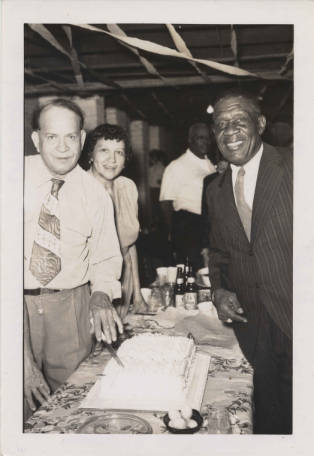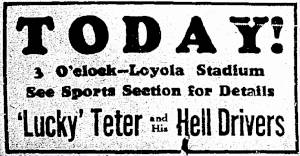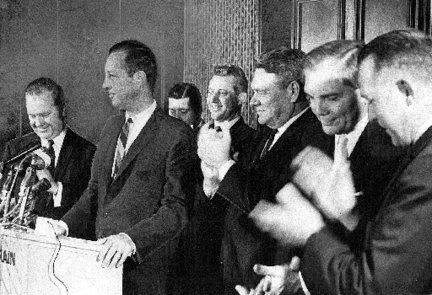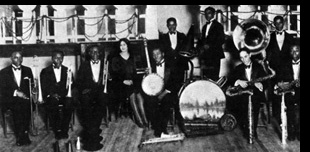|
On December 15, 1968 the Saints beat the Pittsburgh Steelers, in season's final game
to emerge with 4-9-1 record and 3rd place finish in Century Division ... Saints' 2-year record of 7-20-1, was best ever
for an expansion club.
In the summer of that year, some English cotton merchants, no doubt having played the game in their
homeland where it was first patented, were working in New Orleans. They found a lot on Phillip Street near Prytania and
converted it into a makeshift tennis court. These young English sportsmen, along with some congenial New Orleans companions,
joined forces on Dec. 15, 1876. They established a planning committee composed of V. Wallace, G.J. Bratton, George Hartley,
G.R. Westfelt, E. Dobell and Lucas Moore. The newly established planning committee members met with a small group of lawn
tennis enthusiasts to draw up an organizational chart with an avowed purpose of “the advancement and encouragement
of the game of lawn tennis.” On December 15, 1876 the NOLTC became the country’s first lawn
tennis club. Source: Buddy Stall at http://clarionherald.org/20020522/stall.htm
Renato (René) Beluche, born in New Orleans on December 15, 1780, was a privateer
who enlisted in the American forces defending New Orleans against the British invasion of 1814-1815; he commanded one of
the 24-pounders (seacoast cannons -- the heaviest used at the time by the U.S. Army) in Battery No. 3 at Chalmette.
He also commanded the privateer ship Spy under United States letter of marque during War of 1812. As master of several
merchant vessels out of New Orleans, he used the alias Pierre Brugman, Beluche died on October 4, 1860.
Source: http://lahistory.org/site19.php
John
W. Mecom, Jr. Named the Majority Stockholder-President of The Saints
December 15, 1966
On November 1, 1966 the National Football League awarded its
16th franchise to New Orleans. NFL Commissioner Pete Rozelle made the announcement at the now defunct Pontchartrain
Hotel on St. Charles Avenue. The New Orleans States-Item afternoon newspaper produced a "RED FLASH" issue with the
headline "N.O. GOES PRO!" stretched across its first page. The Times-Picayune simply included a small one
column article titled "N.O. To Be Given NFL Franchise". This article was small compared with larger titles
"Viet Cong Shell Heart of Saigon" and "City Levy on Income [Tax] Unlikely, Says [City Council President] Petrie"
-- both articles were alloted vastly more homepage area. But most New Orleanians and many Louisianians were thrilled on that
All-Saints Day to see (and hear) the news. At the
press conference, which was held shortly after 12 noon, Commissioner Rozelle briefly told the story of events leading to the
decision to award the franchise to New Orleans. He said that during the preceding month of May, Governor John McKeithen,
Mayor Victor Schiro, U.S. Senator Russell B. Long (Democratic Senate
Majority Whip), and U.S. Congressman Hale Boggs (Democratic Congressional Majority Whip)
had gone to Washington and "That peaked our interest and got all our people thinking a little more about New Orleans".
What he did not say (but implied to those informed) was that their intent was to support and encourage the passage of a law
proposed in the 89th United States Congress, which would exempt a proposed merger of the NFL with the AFL from antitrust law
sanctions. That law, titled the Senate; Hearings of Subcommittee
on Antitrust and Monopoly (S.Con.Res. 109 of the 89th U.S. Congress) was signed by President Johnson on October 19, 1966 (just
13 days before the awarding of the New Orleans franchise). Boggs and Long were instrumental
in its passage which allowed the two leagues to combine to form an expanded league with additional teams. The first
of those new teams was the Saints. "There is no question", said Rozelle at the press conference on November 1, "that
their leadership [Boggs and Long] in Washington was tremendously significant". The photo was taken at the press conference on November 1, 1966. Photographer: J. W. Guillot / The Times-Picayune.
Russell Long is on the left. Pete Rozelle is at the podium. From right to left are Dave Dixon, John McKeithen, and Hale Boggs.
Dave Dixon was praised by Rozelle for his contributions..."I
guess it started five years ago when David Dixon started hounding our league meetings. He's been pushing it for five
years and I think that the great civic interest he has shown should certainly be recognized here today". The following
day (November 2, 1966), Times-Picayune Sports Editor Bob Roesler wrote that Dixon had contacted NFL Commissioner Bert Beli
and AFL team owners, as early as 1957, regarding a professional team in New Orleans and had worked since then to see this
happen. Dixon was quoted as saying, "I could write 10 books" about experiences along the way. He did,
in fact write one, with the publication of The Saints, the Superdome, and the Scandal which was published on February 15, 2008. Rozelle also
credited John F. Tims, president and publisher of the the Times-Picayune Publishing Company whose support "was another
factor in encouraging us to come here". He praised the support of Tulane officials in regard to the use of the
82,000 seat Sugar Bowl Stadium -- another significant factor in the league's decision to choose New Orleans over six other
cities (Seattle, Cincinnati, Boston, Houston, Phoenix and Portland) vying for the franchise. Of those, he said,
Seattle, Cincinnati, and New Orleans were still in contention as of the week before when NFL and AFL officials visited all
three. When the vote was taken by the 24 team owners, New Orleans was unanimously chosen. Commissioner Rozelle added that New Orleans had the population, the sports interest, the weather, and
the geological location which would ensure the success of a professional team and added that New Orleans was under
consideration for the upcoming January Superbowl. Regarding the team playing at Tulane, Rozelle said it had "an
excellent stadium" but that "a new stadium is a necessity". Councilman Maurice "Moon" Landrieu
represented Mayor Schiro at the press conference, who had other commitments that day. Schiro issued a press release
stating "This will not be just New Orleans' or Jefferson Parish's team. I predict that the Louisiana fans
will be the most fervant in the National League".
No owner for the new team had yet been chosen but three had publicly expressed interest; Louis S. Rousell,
Jack Sanders, and John Mecom Jr. New Orleans businessman and civic activist Edgar Stern had reportedly gathered a group
of local businessmen who were interested in ownership which was unofficially estimated to be $8.5 million payable over five
years. Rozelle said that the team would spit television revenue with the NFL. Finally, Rozelle said that another
team franchise would be added next year in the AFL. In Times-Picayune
Sports Editor Bob Roesler's November 2, 1962 column, he quoted Dave Dixon as saying, "I stumped the state the past two
months for Constitutional Amendment No. 10" which, if passed by the voters, would fund an all-purpose domed facility
in the Greater New Orleans area. Dixen felt that most Louisianians were in favor of it. Also in his column that
day, Roesler wrote, "The New Orleans Saints, or whatever they'll be called, would participate in the mid-January draft".
This was likely the first time the team had ever been referred to as "The Saints" in the print media.
On November 8, 1966 (one week after the franchise was granted),
voters approved the Amendment 10. On December 15, John W. Mecom, Jr. became the majority stockholder-president of franchise.
On December 22, Victor E. Schwenk was appointed director of player personnel, on December 27, Tom Fears was named the head
coach. It wasn't until January 9, 1967 that the team was officially named "Saints".
Oscar "Papa" Celestin Passes
Away December 15, 1954  In 1954 "Lincoln Beach opened to a throng of 10,000 eager citizens, who spilled onto the elaborately landscaped midway
and gathered around the stage where Papa Celestin's jazz band played" noted New Orleans Magazine. He passed away
not long after on December 15, 1954. Born in Napoleonville
on January 1, 1884, he was originally a guitar and mandolin player and worked as a cook on the Texas and Pacific Railroad
before settling in St. Charles where he began playing trombone and trumpet in a local brass band.
He arrived in New Orleans in 1906 and joined the Indiana Brass Band on cornet and played
with the Algiers Brass Band. Later worked with Jack Carey and the Olympia Band and became a member of Henry Allen Sr.’s
Excelsior band in 1908. In 1910 Celestin started the Tuxedo Jazz Orchestra which played at Tuxedo Hall in New Orleans,
from 1910 until it closed in 1913. Musicians in his band included Peter Bocage, Louis Armstrong, Bebe Ridgley, Lorenzo
Tio, Jr and Isidore Barbarin (guitarist Danny Barker’s grandfather). Celestin
also led his own band at Villa Cafe and then co-led a band with Ricard Alexis, later billed as the Original Tuxedo Brass
Band. It was renamed the Tuxedo Brass Band in 1911. Around 1917 he organized, with William Ridgely, the Original Tuxedo
Orchestra, until they split up in 1925 with Celestin leading it himself. Withthis, and other bands he led, he recorded and
toured the Gulf Coast until the early 1930s. Celestin then left full time music but continued to lead his own band in
New Orleans, including at the Pelican Roof in 1939. He worked
in local shipyards during World War II until being seriously injured by a hit-and-run motorist in 1944. After the
war Celestin re-formed his band and began recording for various companies and doing live broadcasts from local radion stations.
He was also a mainstay and tourist attraction on Bourbon Street's Paddock Club until his death. In May, 1953, he went to Washington, D.C. to play for President Eisenhower and appeared later that year
in the film Cinerama Holiday. In view of the tremendous contribution Celestin made in jazz throughout his lifetime, the Jazz
Foundation of New Orleans had a bust made and donated to the Delgado Museum in New Orleans. Celestin is pictured on the right (in the right) in 1950 at Alphonse Picou's 71st birthday party.
Pictured on the left is the Original Tuxedo Jazz Orchestra --
Left to Right: Bill Matthews, Guy Kelly, Papa Celestin, Jeanette Salvant, Narvin Kimball, Joe Lawrence, Chinee Foster,
Joe Rouzon, Simon Marrero, Clarence Hall by Ted Gottsegen Papa Celestin was one of the most popular of New Orleans cornetists
and considered a major player in the development of jazz. Celestine's
bands were known for playing in the regural venues as well as wherever jazz music was needed-- funerals, picnics, or dances.
Sources: http://nutrias.org/~nopl/info/aarcinfo/notabl2.htm, http://lahistory.org/site20.php,and http://www.redhotjazz.com/papa.html
 |
 |







 In 1954 "Lincoln Beach opened to a throng of 10,000 eager citizens, who spilled onto the elaborately landscaped midway
and gathered around the stage where Papa Celestin's jazz band played" noted New Orleans Magazine. He passed away
not long after on December 15, 1954.
In 1954 "Lincoln Beach opened to a throng of 10,000 eager citizens, who spilled onto the elaborately landscaped midway
and gathered around the stage where Papa Celestin's jazz band played" noted New Orleans Magazine. He passed away
not long after on December 15, 1954.





